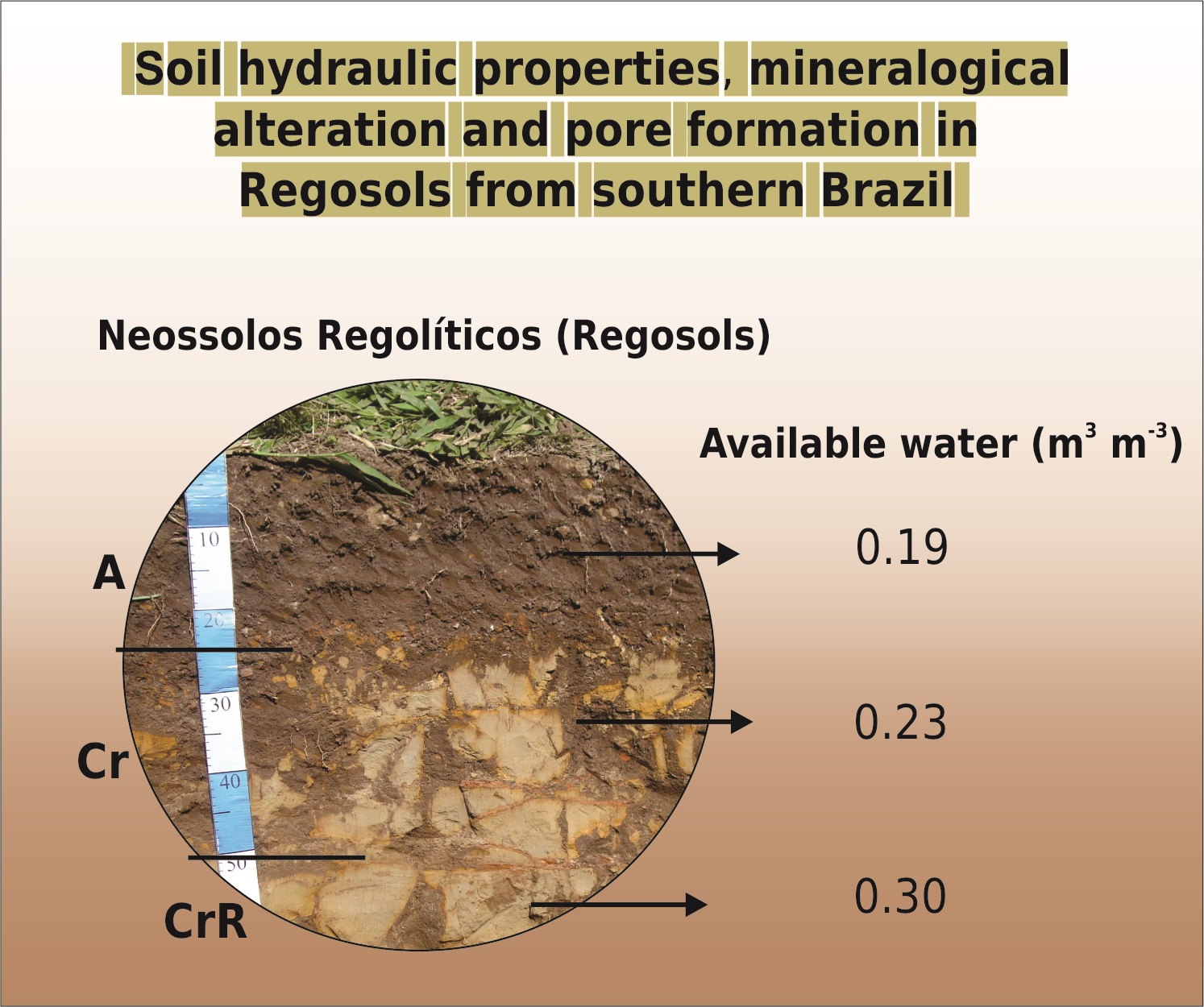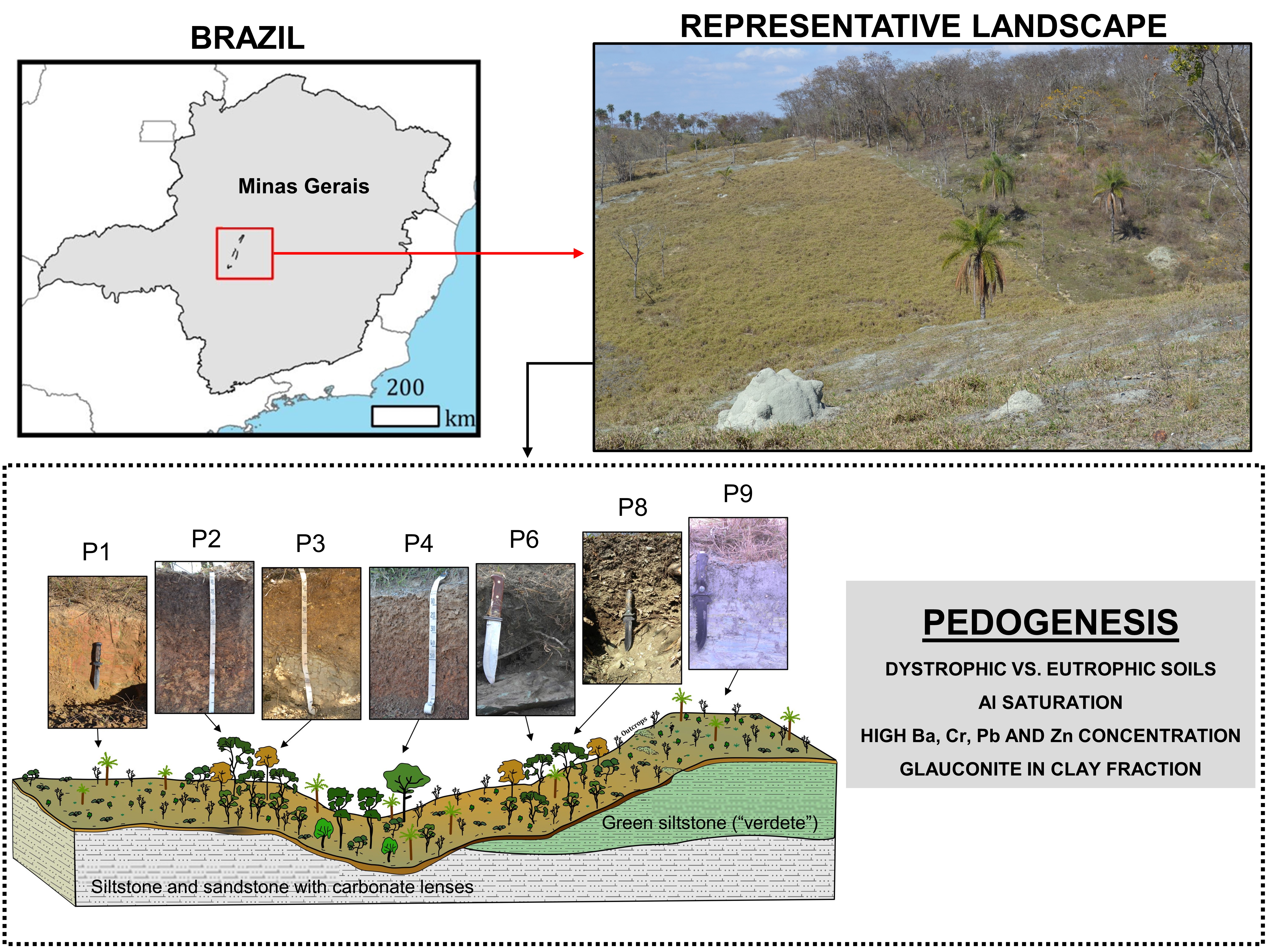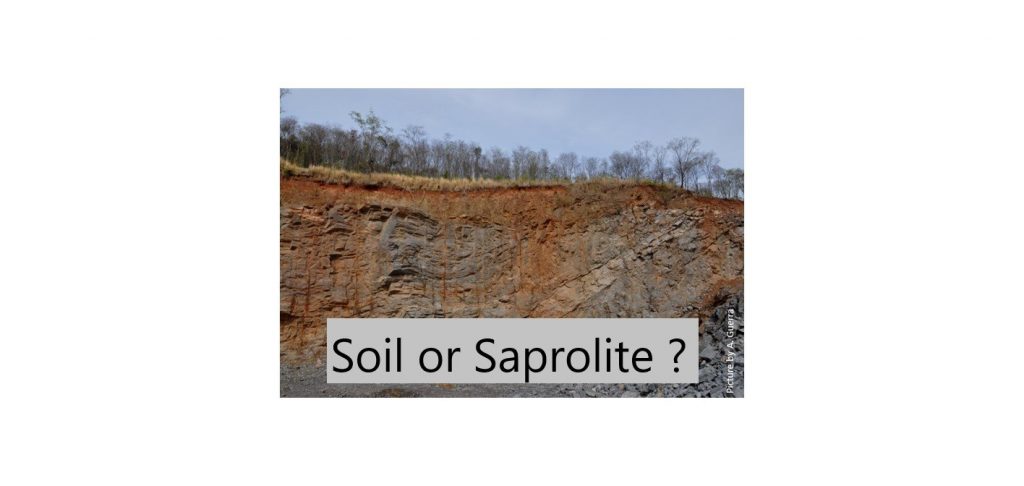Soil hydraulic properties, mineralogical alteration and pore formation in Regosols from southern Brazil
27/Aug/2024
ABSTRACT Regosols (Neossolos) are soils with use limitations mainly related to effective depth, abundant presence of rock and saprolite fragments, and frequently high slope gradients; besides that, they represent a new agricultural frontier for grain production in southern Brazil. This study evaluated soil saturated hydraulic conductivity (Ksat) and water retention and availability in Regosols and saprolites derived from volcanic rocks in southern Brazil and the relationship of these variables with porosity in saprolithic horizons characterized by mineralogical weathering. The study […]
Pedogenesis of pelitic rocks of the Serra da Saudade Formation – Bambuí Group
25/Mar/2024
ABSTRACT Serra da Saudade Formation corresponds to the upper part of the stratigraphic column of the Bambuí Group. Few studies have addressed the soil properties and pedogenesis of the pelitic rocks rich in potassium minerals of this formation. This study analyzed siltstone-derived soils, some of which are glauconitic (green siltstone; “verdete”), to understand the role of the main pedogenetic factors and processes in the landscape of the Central-West region of the Minas Gerais State, covered by Cerrado vegetation. Nine soil […]
Field Perception of the Boundary Between Soil and Saprolite by Pedologists and its Differentiation Using Mathematical Models
19/Jun/2019
ABSTRACT Saprolite plays a central role into hydrologic and nutrient cycles. Despite that, saprolite research is scattered and uses heterogeneous, sometimes conflicting, methods and concepts. During field work, it is difficult to assign the boundary between soil and saprolite. This paper aimed to identify the subjacent logic that pedologists use to assign to a regolith volume its soil or saprolite nature. To achieve this goal, a tree algorithm was used to build a hierarchy of physical and chemical properties of […]
Lithological discontinuity of granite regolith in a small watershed in the amazon forest, in juruena, mato grosso
01/Apr/2012
Tropical landscapes are characterized by complex surface mantles which carry the marks of processes that took place during previous geological periods. However, it is common for vertical layers in the landscape to show morphological characteristics apparently homogeneous, thus hampering the identification of the nature of the source material of their strata. The objective of this study was to analyze the regolith (solum + saprolite) formation from granite of the Xingu Complex in a small watershed covered with Amazonian forest, based […]
Soil genesis and classification in the environment “mar de morros” in the mid-valley of the river Paraiba do Sul, RJ
01/Aug/2010
Brazilian tropical soils are generally regarded as highly weathered, which is attributed to the climatic conditions (high temperatures and rainfall). However, in the “Mar de Morros” environment the intensity of pedogenic processes can be affected by the erosional removal of material, due to the hilly relief, which rejuvenates the surfaces. The objective of this study was to characterize and classify soil profiles in a toposequence developed from muscovite-biotite gneiss, located in the municipality of Pinheiral (Rio de Janeiro State). The […]
Topolitosequences of soils in Alto Paranaíba region: physical, chemical and mineralogical properties
01/Dec/2009
Little is known bout the pedogenetic differentiation in Alto Paranaíba, western Minas Gerais, Brazil, when materials with such a variety of chemical compositions as tufite, alkaline-ultramafic igneous rocks and carbonatites are compared, which are all found in this region. The purpose of this study was to characterize the physical, chemical and mineralogical properties of three representative soil topolitosequences of the Alto Paranaíba region. Therefore, 11 soil profiles were described and collected in the Serra do Salitre, Patrocínio and Coromandel counties, […]
Mineralogy of an Ultisol in the coastal humid zone of Pernambuco, Brazil
01/Apr/2008
Soil mineralogy is an important tool to study and understand soil genesis and soil physical and chemical behavior. Furthermore, soil mineralogy is used as diagnostic criterion to define soil classes in the Brazilian System of Soil Classification and provides information on the potential soil mineral reserve of plant nutrients. In this context, this study presents the mineralogical characterization of gravel, fine and coarse sand fractions (under a binocular lens and petrographic microscope), and of the silt and clay fractions (by […]
Interlayered kaolinite-smectite minerals in an acrisol developed from sandstone parent material in Southern Brazil
01/Dec/2007
Kaolinite is commonly found in fine fractions of tropical and subtropical Brazilian soils. Kaolinite can be verified by an X-ray diffractogram, made of a series of 00l peaks, at the distance of 0.715 nm. However, in some soils, major peaks can be found at about d = 0.720 nm, indicating halloysite or kaolinite-smectite (K-S) interstratified minerals. The objectives of this study were to verify this hypothesis and subsequently discuss soil genesis. Parent material and soil samples from the horizons A1, A2, E and Bt […]
Superficial alteration and pedogeomorphology in the south of the Bação Complex – Quadrilátero Ferrífero – MG, Brazil
01/Aug/2004
This study defines some aspects of superficial alteration processes and their reflexes on the Quaternary pedogeomorphology in the sub-basin of the upper Maracujá River, in the Complexo Bação, ferriferous zone, State of Minas Gerais, Brazil. Characteristics related to the dynamic evolution of three gneiss-underlayered toposequences (1, 2, and 3) at different erosion stages were investigated. In the top slope segments of the toposequences 1 and 2 the soil profiles are little developed and present an in situ evolution. In toposequence 3, […]
Extractable iron forms in soils from the state of Rio de Janeiro, Brazil
01/Jun/1999
The state of Rio de Janeiro, Brazil, is characterized by three main geomorphologic formations, the landform constituted by crystalline rocks, exposed or covered by their alteration products; coastal tablelands, formed by Barreiras Formation Tertiary sediments; and alluvial floodplain sediments of Quaternary age. Differences between parent material and topography and their influence on soil genesis have been the main subject of studies in Rio de Janeiro. The objective of this study was to analyze the behavior of extractable forms of iron, […]



